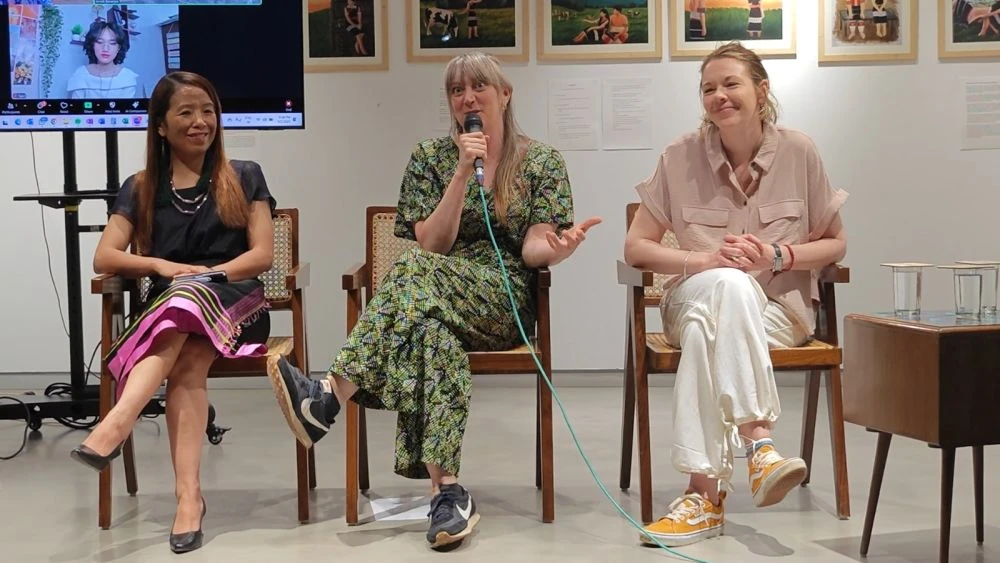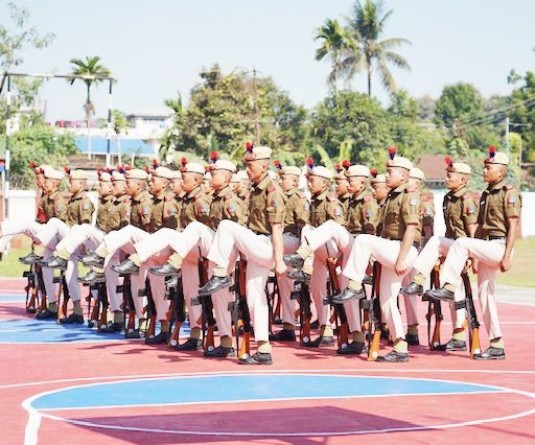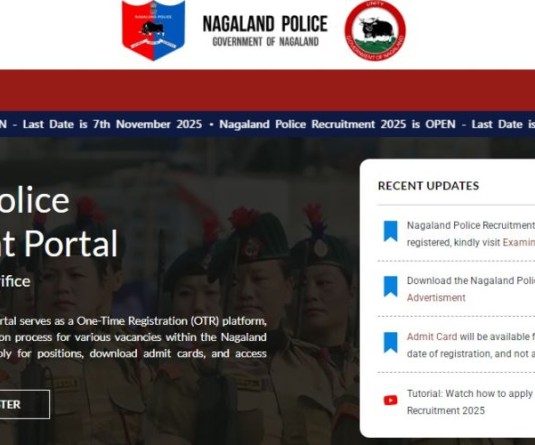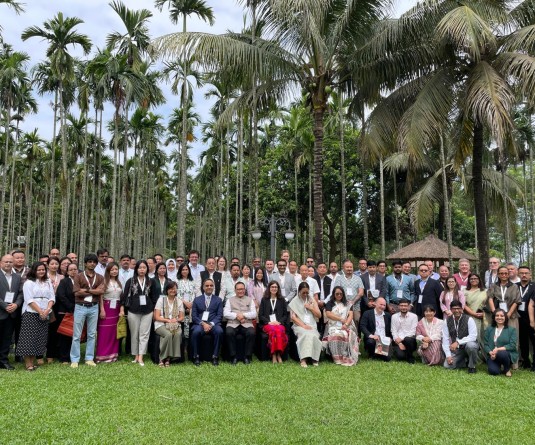L-R: Arnab Banerjee, Founder of Meta Arts India, Vishü Rita Krocha, poet, writer and journalist from Nagaland, Hannah McPake, writer, performer & director and Illustrator, Emily Jones from Wales during the panel on 'A Page of Two Lands' on May 2 at the Public Showcase at Arthshila Santiniketan. Also seen onscreen in the backdrop are Thejavinuo Savi, Illustrator from Nagaland & Arts Producer, Kate Perridge who joined the panel online. (Photo courtesy: Vikramjit Sardar)

Morung Express News
Santiniketan | May 6
Placing women at the centre of narratives, the Art Residency of ‘A Page of 2 Lands’, a cross-cultural collaboration between Wales and Nagaland held at Arthshila Shantiniketan in West Bengal from April 28 to May 2, reflected on indigenous knowledge, traditions and practices and brought to life familiar tales of a place into a new land.
“There are stories that linger in the soil and in the spaces between languages. 'A Page of 2 Lands' began as a desire to listen to and see these stories— and to ask what might happen if they were carried across borders and cultures held in new hands through new voices”, Founder of Meta Arts India, Arnab Banerjee recalled.
He, along with Cardiff-based arts producer, Kate Perridge developed the project that culminated with a public showcase on May 2, featuring the four women writers and artists, dramatised reading of their works and a walkthrough exhibition.
“This exhibition is the result of an extraordinary collaboration between four writers and illustrators from Wales and Nagaland — Emily Jones, Hannah McPake, Vishü Rita Krocha, and Thejavinuo Savi — who met not on a map, but in the shared space of imagination, curiosity, and mutual respect,” Arnab Banerjee remarked.
Further putting across that over months of virtual exchange and in-person residency at Arthshila Shantiniketan, he also stated that, “these artists wove together contemporary interpretations through writings and illustrations of folk narratives rooted in indigenous knowledge, linguistic heritage, and personal memory.”
Impressing upon that these works are as much about process as it is about product, he also noted that, “there are illustrations and stories that lean toward the performance, hinting at theatre, voice, and sound.”
“Some works read like private letters and together they create a map of what it means to meet two cultures with open hands,” he added.
Further describing ‘A Page of 2 Lands’ not only as an exhibition but “an experiment in co-creation, gender equity, and listening — in making space for reimagining voices of traditions that are generally not accessible,” he also highlighted that, “This collaboration was made possible through the support of Wales Arts International, the British Council, and TaFMA Nagaland.”

Bridging women artists and writers from different cultures
While our world can be a dark place filled with hatred, Emily Jones, illustrator from Wales strongly felt that “by having small connections and cultures, we get to learn from each other and make friendships.” She said collaborating with Nagaland was a wonderful experience even while putting across that “I was able to read stories and hear about experiences far different from my own but also discover many similarities between our two cultures.”
“I have learnt that I don't have to be so small with my creative thinking. I can look beyond the UK for narratives. In many ways, we've only scratched the surface in exploring stories shared by our two lands. I know we can continue to share and learn from one another,” she maintained.
Illustrator from Nagaland, Thejavinuo Savi, who was part of the project remotely expressed that, “My experience so far has been absolutely amazing even though I wasn’t physically present. It’s been something new, big, and incredibly exciting all at once.”
Stating that “I have learned so much about our own culture—especially the rich variety of folktales we have”, she also underscored that, “growing up, folktales from Nagaland were never really a part of our school curriculum, so revisiting them now, especially from different tribes, was truly eye-opening.”
“What struck me the most was discovering the beautiful similarities between our folktales and those from Wales. Despite being worlds apart, it was mesmerising to see how these stories echo one another in bits and pieces—it felt magical”, she went on to say.
Writer, Performer & Director from Wales, Hannah McPake acknowledged that she knew very little about Nagaland and its Arts scene, but however felt that, “it has been really exciting to discover Rita and Savi’s work and to have the opportunity to collaborate on stories from both our homelands in a new form.”
Also underlining the fact that this has been a women focused project, she said, “it has impacted both the way we’ve worked and the content we’ve created, celebrating or in some cases reimagining female folk stories.”
She felt that they have definitely only just scratched the surface, and reiterated that, “there is lots still to explore and I hope we get a chance to work together in the future.”
And perhaps, she added, “create work that weaves the folk stories of the two lands together more” which could further enable other artists from Nagaland and Wales to have a chance to collaborate in the future.
Poet, writer & journalist from Nagaland, Vishü Rita Krocha said that the collaboration unfolded a new experience while asserting that it amplified women's voices from marginalised communities. She also spoke about the story she chose for the project titled “Durüle & Sacho”, a love story of two cow herders while highlighting that the story chosen was narrated to her by her grandmother, a strong, resilient woman whose life was worth emulating. This, she said was one of the first things that aligned with the women centric project while deciding to choose from among the several folktales that Nagaland is home to.
She further stated that the story represents the Naga culture and tradition in a lot of ways while also putting across that the folktale was reimagined with added elements to the characters to make it more relevant. She said the collaboration allowed the artists to delve into myths and legends of two completely different nations but also the joy of discovering many similarities in the ancient tales of the two places comprising of fascinating supernatural elements, friendships between animals and humans, stories of transformation, that sense of community and familial ties, songs and weaving, that form a significant fabric of the Naga culture wherein every motif and design embedded in the traditional attires has a meaning and a story behind it.






